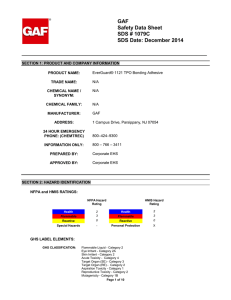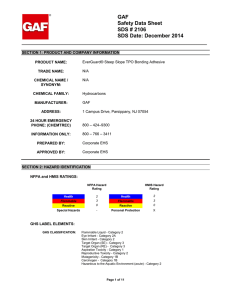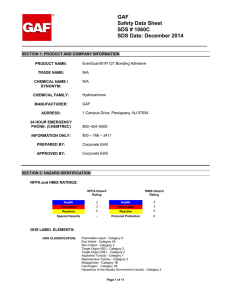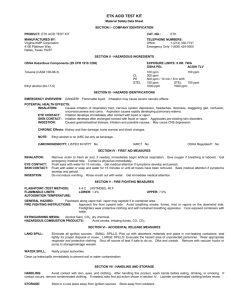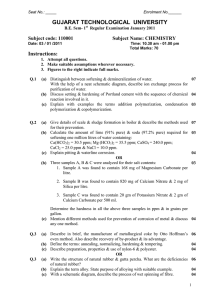GAF Safety Data Sheet SDS # 2101 SDS Date: December 2014
advertisement
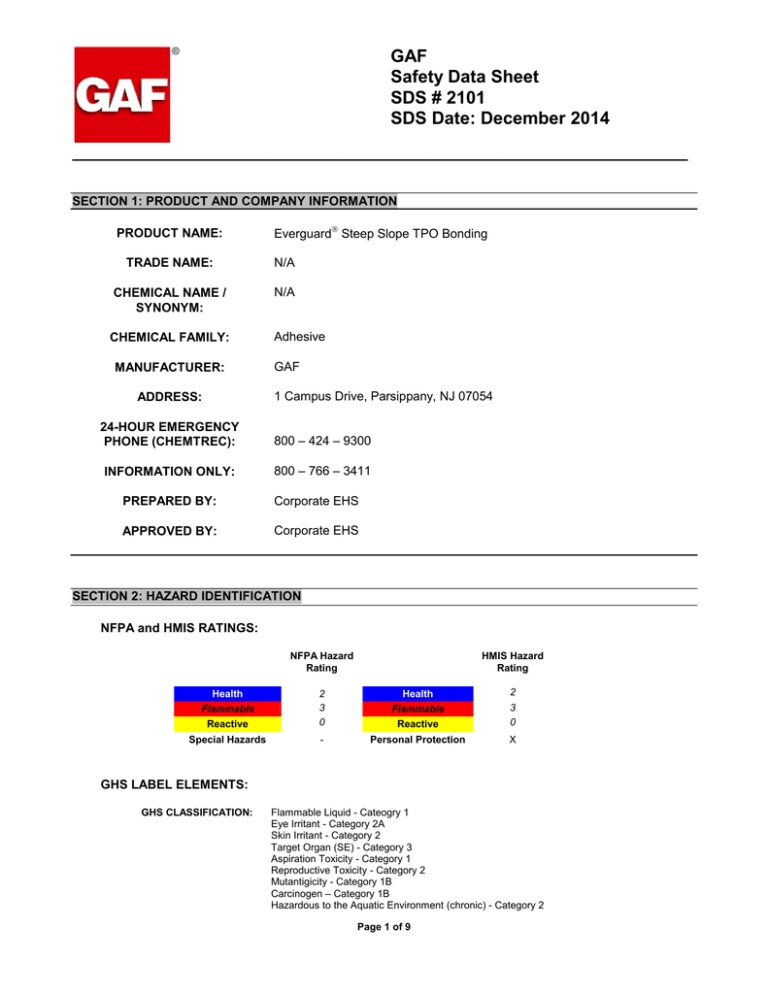
GAF Safety Data Sheet SDS # 2101 SDS Date: December 2014 _________________________________________________________________________ SECTION 1: PRODUCT AND COMPANY INFORMATION PRODUCT NAME: Everguard Steep Slope TPO Bonding TRADE NAME: N/A CHEMICAL NAME / SYNONYM: N/A CHEMICAL FAMILY: Adhesive MANUFACTURER: GAF 1 Campus Drive, Parsippany, NJ 07054 ADDRESS: 24-HOUR EMERGENCY PHONE (CHEMTREC): 800 – 424 – 9300 INFORMATION ONLY: 800 – 766 – 3411 PREPARED BY: Corporate EHS APPROVED BY: Corporate EHS SECTION 2: HAZARD IDENTIFICATION NFPA and HMIS RATINGS: NFPA Hazard Rating HMIS Hazard Rating Health 2 Flammable Reactive 2 3 0 Flammable Reactive 3 0 Special Hazards - Personal Protection X Health GHS LABEL ELEMENTS: GHS CLASSIFICATION: Flammable Liquid - Cateogry 1 Eye Irritant - Category 2A Skin Irritant - Category 2 Target Organ (SE) - Category 3 Aspiration Toxicity - Category 1 Reproductive Toxicity - Category 2 Mutantigicity - Category 1B Carcinogen – Category 1B Hazardous to the Aquatic Environment (chronic) - Category 2 Page 1 of 9 GAF SDS # 2101 GHS PICTOGRAMS: SIGNAL WORD: HAZARD STATEMENTS: Danger Extremeley flammable liquid and vapor May cause damage to organs through prolonged or repeated exposure Causes skin irritation Causes serious eye irritation May cause drossiness or dizziness Suspected of damaging fertility or the unborn child May be fatal if swallowed and enters airways May cuase genetic defects May cause cancer Toxic to aquatic life with long lasting effects ADDITIONAL HAZARD IDENTIFICATION INFORMATION: PRIMARY ROUTE OF EXPOSURE: Inhalation, Skin, Eye, Ingestion SIGNS & SYMPTOMS OF EXPOSURE EYES: May cause irritation to the eyes. Symptoms include stinging, tearing, redness, and swelling of the eyes. SKIN: May cause skin irritation. Symptoms may include redness and burning of skin, and other skin damage. Prolonged or repeated contact may dry skin. Symptoms may include redness, burning, and drying and cracking of skin, skin burns, and other skin damage. INGESTION: Swallowing small amounts of this material during normal handling is not likely to cause harmful effects. Swallowing large amounts may be harmful. This material can get into the lungs during swallowing and vomiting. This results in lung inflammation and other lung injuries. INHALATION: Breathing of vapor or mist is possible. Breathing small amounts of this material during normal handling is not likely to cause harmful effects. Breathing large amounts may be harmful. Symptoms are not expected at air concentrations below the recommended exposure limits. May cause allergic respiratory reaction. ACUTE HEALTH HAZARDS: Preexisting disorders of the following organs (or organ system) may be aggravated by exposure to this material; Upper respiratory track, skin, lung, liver, kidney, central nervous system, bloodforming system, male reproductive system, auditory system. Individuals with preexisting heart disorders may be more susceptible to arrhythmias is exposed to high concentrations of this material. CHRONIC HEALTH HAZARDS: Overexposure to this material has been suggested as a cause of Page 2 of 9 GAF SDS # 2101 the following effects in humans; kidney damage, visual impairment, central nervous system effects. Toluene may be harmful to the human fetus based on positive test results with laboratory animals. Case studies show that prolonged intential abuse of toluene during pregenancy can cause birth defects in humans. Prolonged intentional toluene abuse may lead to hearing loss progressing to deafness. Prolonged and repeated exposure to n-hexane may cause peripheral neuropathy by damaging peripheral nerve tissue and result in muscular weakness and loss of sensation. Ethyl benzene has been shown to cause cancer in laboratory animals. The relevance of this finding in humans is uncertain. The International Agency for Research on Cancer (IRAC) has classified ethyl benzene as a possible human carcinogen (Group 2B). CARCINOGENICITY: SECTION 3: COMPOSITION/INFORMATION ON INGREDIENTS OCCUPATIONAL EXPOSURE LIMITS CHEMICAL NAME CAS # % (BY WT) OSHA ACGIH OTHER Toluene 108-88-3 30-40% 200 ppm 300 ppm – ceiling 20 ppm REL: 100 ppm 150 ppm STEL Acetone 67-64-1 20-30% 1000 ppm 500 ppm 750 ppm STEL REL: 250 ppm Solvent Naphtha (Petroleum), Light Aliphatic 64742-89-8 5-10% NE 300 ppm REL: 350 mg/m3 1800 mg/m3 – ceiling N-Hexane 110-54-3 5-10% 500 ppm 50 ppm REL: 50 ppm Cyclohexane 110-82-7 1.5-5% 300 ppm 100 ppm n-Heptane 142-82-5 1-1.5% 500 ppm 400 ppm REL: 300 ppm REL: 85 ppm Ethyl Benzene 100-41-4 0.1-0.5% 100 ppm 100 ppm NE = Non Established SECTION 4: FIRST AID MEASRURES FIRST AID PROCEDURES Page 3 of 9 REL: 100 ppm GAF SDS # 2101 EYES: Immediately move individual away from exposure and into fresh air. Flush eyes gently with water for at least 15 minutes while holding eyelids apart. Seek immediate medical attention. SKIN: Remove contaminated clothing. Flush exposed area with large amounts of water. If skin is damaged, seek immediate medical attention. If skin is not damaged and symptoms persist, seek immediate medical attention. Launder clothing before reuse. INHALATION: Immediately move individual away from exposure and into fresh air. Seek immediate medical attention; keep individual warm and quiet. If breathing is difficult, administer oxygen. INGESTION: Seek immediate medical attention. If individual is drowsy or unconscious, do not give anything by mouth; place individual on the left side with the head down. Contact a physician, medical facility, or poison control center for advice about whether to induce vomiting. If possible, do not leave individual unattended. NOTES TO PHYSICIANS OR FIRST AID PROVIDERS: Inhalation of high concentrations of this material, as could occur in enclosed spaces or during deliberate abuse, may be associated with cardiac arrhythmias. Sympathomimetic drugs may initiate cardiac arrhythmias in persons exposed to this material. This material is an aspiration hazard. Potential danger from aspiration must be weighed against possible oral toxicity when deciding whether to induce vomiting. This material (or a component) has produced hyperglycemia and ketosis following substantial ingestion. SECTION 5: FIRE FIGHTING PROCEDURES SUITABLE EXTINGUISHING MEDIA: Dry chemical, Carbon Dioxide (CO2) HAZARDOUS COMBUSTION PRODUCTS: Carbon dioxide and carbon monoxide, Hydrocarbons. RECOMMENDED FIRE FIGHTING PROCEDURES: Wear self-contained breathing apparatus and full protective clothing. Material is volatile and readily gives off vapors. Water may be ineffective for extinguishment unless used under favorable conditions by experienced fire fighters. Use water spray to cool fire exposed containers and structures until fire is out if it can be done with minimal risk. Avoid spreading burning liquid with water used for cooling purposes. UNUSUAL FIRE & EXPLOSION HAZARDS: Vapors may accumulate and travel to ignition sources distant from handling site. Isolate from heat, sparks, and open flame. Never use welding or cutting torch on or near drum (even empty) because product (even just residue) can ignite explosively. SECTION 6: ACCIDENTAL RELEASE MEASURES Page 4 of 9 GAF ACCIDENTAL RELEASE MEASURES: SDS # 2101 Contain spillage and collect with non-combustible absorbent material and place in container for disposal. Suppress gases/vapors/mists with a water spray jet. Prevent run-off to sewers, streams or other bodies of water. SECTION 7: HANDLING AND STORAGE HANDLING AND STORAGE: Containers of this material may be hazardous when emptied. Electrically bond and ground all containers, personnel and equipment before transfer or use of material. Special precautions may be necessary to dissipate static electricity for nonconductive containers. Use proper bonding and grounding during product transfer. Store in a cool, dry, ventilated area, away form incompatible substances. Keep containers closed when not in use. Do not store near extreme heat, open flame, or sources of ignition. OTHER PRECAUTIONS: N/A SECTION 8: EXPOSURE CONTROLS/PERSONAL PROTECTION ENGINEERING CONTROLS / VENTILATION: Provide sufficient mechanical ventilation to maintain exposure below exposure guidelines or below levels that cause known, suspected or apparent adverse affects. RESPIRATORY PROTECTION: A NIOSH-approved air-purifying respirator with an appropriate cartridge and/or filter may be permissible under certain circumstances where airborne concentrations are expected to exceed exposure limits or if overexposure has otherwise been determined. Protection provided by air-purifying respirators is limited. Use a positive pressure, air-supplied respirator if there is any potential for uncontrolled release, exposure levels are not known or any other circumstances where an air-purifying respirator may not provide adequate protection. EYE PROTECTION: Wear chemical splash goggles when there is the potential for exposure of the eyes to liquid, vapor or mist. SKIN PROTECTION: Wear normal work clothing including long pants, long-sleeved shirts and foot covering to prevent direct contact of the product with the skin. Launder clothing before reuse. OTHER PROTECTIVE EQUIPMENT: Eye washes and safety showers could also be provided. WORK HYGIENIC PRACTICES: Wash thoroughly after handling and before eating or smoking. EXPOSURE GUIDELINES: N/A Page 5 of 9 GAF SDS # 2101 SECTION 9: PHYSICAL AND CHEMICAL PROPERTIES APPEARANCE & ODOR: Amber liquid with a slight odor. FLASH POINT: o o 0.0 F (-17.78 C) LOWER EXPLOSIVE LIMIT: No data No data UPPER EXPLOSIVE LIMIT: No data METHOD USED: o EVAPORATION RATE: > 1 (butyl acetate = 1) BOILING POINT: 131 – 289 F o (55 – 143 C) pH (undiluted product): No data MELTING POINT: No data SOLUBILITY IN WATER: Immiscible SPECIFIC GRAVITY: No data PERCENT VOLATILE: No data MOLECULAR WEIGHT: No data WITHOUT WATER (LBS/GAL): No data No data VAPOR DENSITY: VAPOR PRESSURE: 46.10 hPa VOC WITH WATER (LBS/GAL): No data SECTION 10: STABILITY AND REACTIVITY THERMAL STABILITY: STABLE X UNSTABLE CONDITIONS TO AVOID (STABILITY): N/A INCOMPATIBILITY (MATERIAL TO AVOID): Strong acids, Strong oxidizing agents, Acids, Alkalis, Reducing agents. HAZARDOUS DECOMPOSITION OR BYPRODUCTS: Carbon dioxide and carbon monoxide, Hydrocarbons. HAZARDOUS POLYMERIZATION: Will not occur. __________________________________________________________________________________________ SECTION 11: TOXICOLOGICAL INFORMATION TOXICOLOGICAL INFORMATION: Acute Oral Toxicity Toluene Acetone LD 50 Rat: 2,600-7,500 mg/kg LD 50 Rat: 5,800 mg/kg Page 6 of 9 GAF SDS # 2101 Solvent Naphtha (Petroleum), Light Aliphatic N-Hexane Cyclohexane n-Heptane Ethyl Benzene LD 50 Rat: > 8,000 mg/kg LD 50 Rat: 25 mg/kg LD 50 Mouse: 1,300 mg/kg LD 50 Rat: 29,820 mg/kg LD 50 Rat: > 15,000 mg/kg LD 50 Rat: 3,500 mg/kg Acute Inhalation Toxicity Toluene Acetone Solvent Naphtha (Petroleum), Light Aliphatic N-Hexane Cyclohexane n-Heptane Ethyl Benzene LC 50 Rat: 8000 ppm, 4h LC 50 Rat: > 16000 ppm, 4h LC 50 Rat: 3400 ppm, 4h LC 50 Rat: 48000 ppm, 4h LC 50 Rat: > 4044 ppm LC 50 Rat: 103 g/m3, 4h LC 50 Rat: 4000 ppm, 4h Acute Dermal Toxicity Toluene Acetone LD 50 Rabbit: 12,124 mg/kg LD 50 Rabbit: > 20,000 mg/kg Solvent Naphtha (Petroleum), Light Aliphatic N-Hexane Cyclohexane n-Heptane Ethyl Benzene LD 50 Rat: > 4,000 mg/kg LD 50 Rabbit: > 1.3 g/kg LD 50 Rabbit: > 2.0 mg/kg LD 50 Rabbit: > 2,001 mg/kg LD 50 Rabbit: 15,433 mg/kg SECTION 12: ECOLOGICAL INFORMATION ECOLOGICAL INFORMATION: N/A __________________________________________________________________________________________ SECTION 13: DISPOSAL CONSIDERATIONS WASTE DISPOSAL METHOD: Dispose of containers and absorbed material in accordance with all federal, state, and local requirements. RCRA HAZARD CLASS: See Above. SECTION 14: TRANSPORTATION INFORMATION U.S. DOT TRANSPORTATION PROPER SHIPPING NAME: ADHESIVES, 3, UN1133, II HAZARD CLASS: 3 Page 7 of 9 GAF SDS # 2101 ID NUMBER: UN1133 PACKING GROUP: Flammable liquid LABEL STATEMENT: 49 CFR 172.101 Adhesives, UN1133, IMDG o Class 3.2, Pg. 3174, Flash Point <40.01 F o (4.45 C) OTHER: N/A SECTION 15: REGULATORY INFORMATION U.S. FEDERAL REGULATIONS TSCA: This product and its components are listed on the TSCA 8(b) inventory. CERCLA: Toluene 108-88-3 1000 lbs Acetone 67-64-1 5000 lbs N-Hexane 110-54-3 5000 lbs Cyclohexane 110-82-7 1000 lbs Ethyl Benzene 100-41-4 1000 lbs SARA 311/312 HAZARD CATEGORIES: Fire Hazard, Acute Health Hazard, Chronic Health Hazard 313 REPORTABLE INGREDIENTS: Toluene 108-88-3 N-Hexane 110-54-3 Cyclohexane 110-82-7 Ethyl Benzene 100-41-4 CALIFORNIA PROPOSITION 65: 38.84% 6.4032% 1.6968% 0.2601% This product contains a chemical known to the state of California to cause cancer and birth defects, or other reproductive harm; Toluene, Benzene. Other state regulations may apply. Check individual state requirements. The following components appear on one or more of the following state hazardous substances lists: Chemical Name CAS # CA MA MN NJ PA RI Toluene 108-88-3 Yes Yes Yes Yes No Yes Acetone 67-64-1 No No No Yes No No Solvent Naphtha (Petroleum), Light Aliphatic 64742-89-8 Yes Yes Yes Yes Yes Yes N-Hexane 110-54-3 No Yes Yes Yes Yes Yes Page 8 of 9 GAF SDS # 2101 Cyclohexane 110-82-7 Yes Yes Yes Yes Yes Yes n-Heptane 142-82-5 No Yes Yes Yes Yes Yes Ethyl Benzene 100-41-4 Yes Yes Yes Yes No Yes SECTION 16: OTHER INFORMATION ADDITIONAL COMMENTS: N/A DATE OF PREVIOUS SDS: October 2014 CHANGES SINCE PREVIOUS SDS: Headquarters Address Change This information relates to the specific material designated and may not be valid for such material used on combination with any other materials or in any process. Such information is to the best of our knowledge and belief accurate and reliable as of the date compiled. However, no representation, warranty or guarantee, expressed or implied, is made as to its accuracy, reliability, or completeness. It is the user’s responsibility to satisfy himself as to the suitability and completeness of such information for his particular use. We do not accept liability for any loss or damage that may occur from the use of this information. Nothing herein shall be construed as a recommendation for uses which infringe valid patents or as extending a license of valid patents. Page 9 of 9


